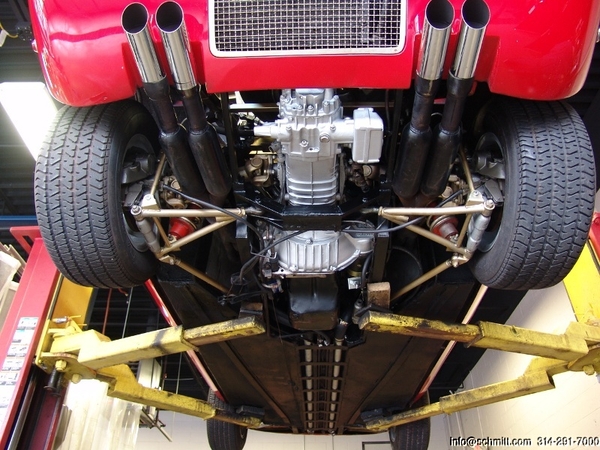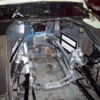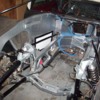The copper rivets were esp used whenever there was any contact between steel and aluminum—for example, the steel braces against the carpeted aluminum engine covers, or the cast air intakes on the engine wall sides (terminating near the battery on the left and jack), or a few on the hood. Galvanic corrosion esp between the gullwing engine covers and the steel chassis is common on the Goose, and requires electrical isolation (paint and/or tape when the surfaces are crimped together) and use copper rivets…otherwise, moisture and dissimilar metal creates a battery (!) Lee
The copper rivets were esp used whenever there was any contact between steel and aluminum—for example, the steel braces against the carpeted aluminum engine covers, or the cast air intakes on the engine wall sides (terminating near the battery on the left and jack), or a few on the hood. Galvanic corrosion esp between the gullwing engine covers and the steel chassis is common on the Goose, and requires electrical isolation (paint and/or tape when the surfaces are crimped together) and use copper rivets…otherwise, moisture and dissimilar metal creates a battery (!) Lee
Greg,
Missed one point when I was looking..... the lower mount for the inner rear a-arm Unibal joints.... As built that "H" shaped piece is held only to the rest of the chassis on one side of the "H".
As you have added the other upper reinforcements in the rear suspension area, I would consider building the rear side of the "H" up to the frameworks. BUT, that area of the long arms going to the rear of the frame looks different from what I remember seeing....... I have not heard of any of these breaking off.......but, what do I know! Perhaps others with early cars can chime in!!! Need to do a little sleuthing to see what's what here!
Found a couple of shots of my rear engine bay showing "mid production" build!
NICE WORK!!!!
Steve
Attachments
I got some more work done on the 1968 Mangusta. Epoxy primer on the floors, engine compartment, wheelhouses, and front frame area. Seal sealer and undercoating where needed. Now I am starting to do the smoothing, straightening, and filler work. I hope to have the rest of the car in epoxy primer soon.
Attachments
Wowza... That is impressive work... Perhaps the inspiration needed to jump back into the rabbithole on my own wild goose chase
MH
Great documentation. I can see this being handy to someone down the road.
Greg, I was thinking last week about you and eager to see an update....wow, are you making great progress. Looks absolutely great.
AAAAGH! BOOGER WELDING ABOUNDS....or as I also call it "worm welding"....as if you squeezed a worm a few times to get piles of poo like you found!!! Now, you also say that some of this may have been from prior "repairs" due to offroading experience........ BUTT, I have seen pic's of factory welding that looked very similar to what you have!
Then there are other cars, that have really proper nice welding throughout...... My car had beautiful welds, but I never knew where the factory ended and prior owners continued.........in "clean up" and restore or "show car" efforts!
You had asked about the numbers and frame markings near the serial number.....have never seen the format that you have here! "Normally" you find some sort of a star then an 8MAxxxx and another star.......but your car being only the 42'cnd ish car built..... things were probably sort of fluid......!!!
Outstanding progress!!!!
Cheers,
Steve
Attachments
Never thought I'd see the day. The car has been primered and block sanded several times and is in finish primer. Next I will rebuild the doors and engine covers. Then I will tackle the removable roof.
straight and solid...that car is going to look great even 100 years from now. Will be fun to see how you engineer the detachable roof....Lee
Nice job Greg.
I finally made some time this last week to rebuild one of my Mangusta doors. As you can see I didn't have a lot to work with but I found a small section of one of the two doors that I could use a profile gauge on to make a pattern. So after bending up the lower door repair and making the two corners I could then start on making the outer lower skin. I had the door on and off about a dozen time to tweak the gaps and then tack weld it together but it's pretty close. A little more adjustment here and there and I can then take the door off again and finish welding it.
Attachments
True artisan work. Congrats
What's behind door number two? The same thing as door number one....rust! Big surprise, I know. However, this door repair represents the last of the actual rust that needed to be dealt with on this huge project. I still have to address the galvanic corrosion in the rear engine gullwings but that's a different process and I will most likely deal with that when the car is back on the ground. My goal is to do some additional reinforcements to the front lower control arms and repaint all the suspension pieces and then for the first time in 20 years place this Mangusta back on it's wheels. Hopefully this will happen by spring. Wish me luck.
Attachments
Greg, have a look at "late" production control arms Steve has for sale, as they have some additional reiforcements. 1968 1969 1970 DeTomaso Mangusta PAIR of Front Lower A-arms NOS Last revision | eBay. Also I would recommend adding the rear gussets even if you are not tracking the car. Keep up the great work. Denis
Greg, this transformation from a 50+ year old car with red overcoat to a really solid, last forever body is just fantastic to watch. It is so much harder to rebuild than build, and it looks so incredible.
The galvanic corrosion on the wings is very common, and the remedy is electrical isolation (with tape and/or paint over the steel frame). If your ability with aluminum is as good as what you do with steel, can't wait to see more pictures.
But wow, you are making good progress to a great car...Lee
I started working on my suspension this week with the hope of getting it done in time to put this car back on the ground by springtime. This Mangusta has not been on it's wheels since the previous owner bought it over 20 years ago. First I reinforced the front lower control arms more or less the way DeTomaso did on later production cars. There were some additional reinforcements done on these arms by someone else but they looked even sturdier than factory so I left them alone. Then as I was sandblasting the components in preparation for painting I noticed evidence of some kind of plating on the parts so I decided to go that way instead. I am going to have them plated in gold zinc which may not be correct but will provide a nice contrast. 
Attachments
Greg, Dick Ruzzin and Jonny Woods wrote various articles, this is one I could find quickly which explains, and I have incorporated this modification on my car.
https://pantera.infopop.cc/top...ruzzindesign-aol-com
There are various points covered, all good to incorporate as you move forward
there may be other posts as well.
I spoke to Jonny, basically most of the arms have rose or Heim joints. One that doesn’t is critical and a lot of people have incorporated joints at each end. This stops the rear wheel going toe in to toe out as it travels up / down during hard cornering.
That was a major criticism in the day. keep the original arms but suggest you consider the extra joint.
Ps I’ve sent you an email regarding the steering rack
cheers
Oh, so that's what a clean ZF looks like. I was wondering. Thanks.




